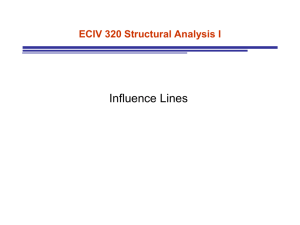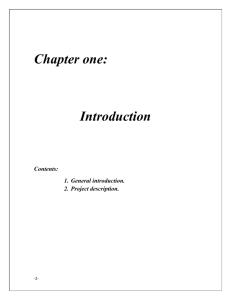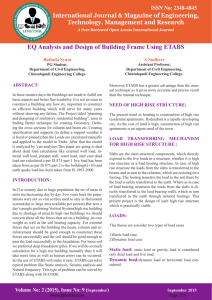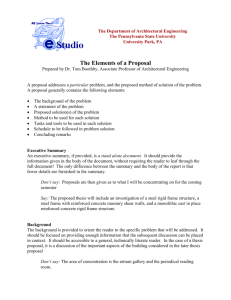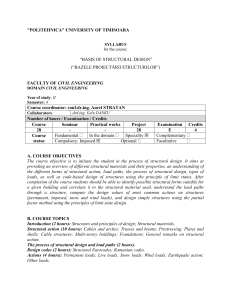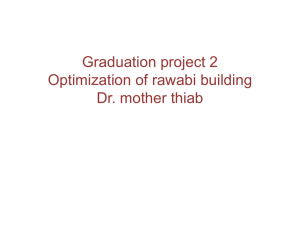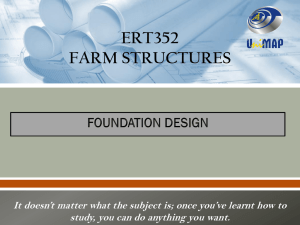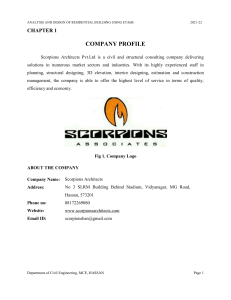Earthquake Geotechnics - An
advertisement
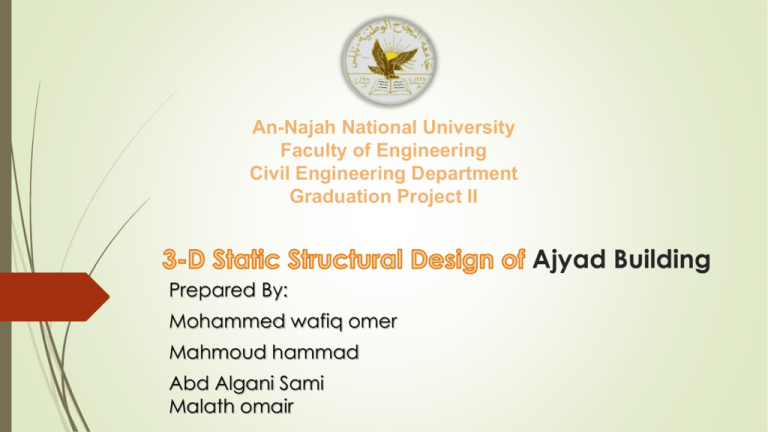
An-Najah National University Faculty of Engineering Civil Engineering Department Graduation Project II Ajyad Building Prepared By: Mohammed wafiq omer Mahmoud hammad Abd Algani Sami Malath omair Presentation Outline Project Description. Design Determinants. 3D- Modeling & Checks. Preliminary Design. Static Design. Slabs. Beams. Columns. Shear walls. Footings. Seismic design This project is a structural analysis and design of “Ajyad” building which lies in “Nablus city – Beit Wazan”. The building consists of seven floors and will be used as residential building. with a total area of 2940 m2 and an area for each floor of 420 m2 Materials Concrete: the compressive strength fc = 28 Mpa. The unit weight of the concrete is 25kN/m3. Steel: Steel yielding strength fy = 420 Mpa. modulus of elasticity (E) of 200Gpa. Soil: Soil bearing capacity is 250 kN/m2 . Materials Non – structural material Elements with the following unit weights: Loads Loads are divided into two categories, gravity and lateral. A- For gravity loads: 1. Dead loads: Own weight of structural elements. Superimposed dead load (S.I.). Which is the own weight of non-structural elements such as the weight of partitions, mortar, tiles, filler under the tile sand plaster. Partitions Weight = weight of all partition wall / area of floor = 1 kN/ S.I. = partitions weight +mortar +tiles +filler +plaster. =1kN/ + 0.03*25+0.02*23+0.1*18+0.015*23 = 4.355 KN/m2 Loads Wall weight. Wall weight = weight of masonry stone + weight of plain concrete + weight of polystyrene+ weight of block +weight of plaster. Wall weight = 3.0*(0.015(23)+0.1(12)+0.02(0.3)+0.13(23)+0.05(27)) =17.7KN/m Loads Live load: This type of load results from the use and occupancy weights. Our structural model is residential, so we have a uniform live load for the structure . According to IBC-2009/sec.1607/table 1607.1, we will take a live load for the residential buildings as: Residential : 2.5 kN/ Codes In order to determine the required loads and structural elements dimensions, the structure is designed using practicecodes and specifications that control the design process. These codes are: ACI 318-08 : American Concrete Institute provisions for reinforced concrete structural design. IBC-2009: International Building Code. UBC-1997: Uniform Building Code. Load combination: The ultimate design method is used in this project. In this method, different load factors are used for different types of loads. According to "ACI 318-08 9.2.1" The load factors (combinations) are: Wu=1.4 D Wu=1.2 D +1.6 L Wu=1.2D.L +1.0L.L ±1.0E Wu=0.9 D ±1.0 E Where: D: Dead load. L: Live load. E: Earthquake load. Computer Programs: ETABS (13.1.5) : this program is used to analyze and design the structural elements. AutoCAD: this program is used to draw structural details. Compatibility: The structure works as one unit is verified. Check for Equilibrium: Check for Deflection: The structural system used is one way ribbed slab with main beams in Xdirection and secondary beams in Y-direction. 2.3.1 Slab Analysis and Design: The section dimensions for the ribbed slab are shown in figure 2.3. According to ACI code: bw= 120 mm ≥ 100mm h = 300 mm ≤ 3.5 bw=3.5X120=420 mm. S = 400 mm ≤ 750mm. hf = 60 mm ≥ 50mm. ≥S/12=400/12=33.33 mm. Rib dimensions are OK Wu for one way slab: block = 12 kN/m3 Own weight/rib = [(0.52*0.06)+(0.12*0.24)]*25 +(0.4*0.24*12)= 2.65 kN/rib Own weight/m2 = 2.65/0.52 = 5.1 kN/m2. Wu = 1.2 DL + 1.6 LL = 1.2 (5.1+3.36) + 1.6 (2.5) = 14.32 kN/m2. Wu/rib = 14.32X0.52 = 7.446 kN/m/rib. Shear Analysis and Design: Flexure Analysis and Design: Beam Analysis and Design: Design is made for the bottom floor columns according to the subjected loads on them which are: Axial force. Bending moment. Check Slenderness The main function for footing is to carry the whole loads from columns and distribute it over a larger area on the ground. In this Project we decided to use a Single footing Type due to main reasons: Firstly, The Bearing Capacity (qall) of the soil is 250 kN/m2. secondly, The Ultimate Moments on the footing is negligible as we compare it with the axial loads. Taking footing F6 Column #8 to be calculated: column dimensions(30*90)cm. to get the area of the footing, assume (M=0). qall = 250 kN/m2. Pu = 2380 kN. A. Equivalent static method B. Dynamic analysis a) Response spectrum analysis b) Time history analysis Structural period Using Rayleigh formula , structural properties and deformational characteristics Dynamic analysis: Initial base shear from etabs Final base shear from etabs Determine the distribution of base shear and calculation the internal forces: Distribution of base shear STORY 0 1 2 3 4 5 6 7 Hx 0 5.4 8.4 11.4 14.4 17.4 20.4 23.4 Wi(KN) 0 671.73 529.9 529.9 529.9 529.9 529.9 529.9 Wi*hx 0 3627.342 4451.16 6040.86 7630.56 9220.26 10809.96 12399.66 54179.8 Cvx 0 0.06695 0.082155 0.111497 0.140838 0.170179 0.19952 0.228861 Fx manual 0 281.04706 344.87661 468.04683 591.21705 714.38727 837.55748 960.7277 sum 4197.86 3916.8129 3571.9363 3103.8895 2512.6725 1798.2852 960.7277 Fx etabs 0 4282.85 4032.343 3670.08 3175.925 2549.878 1791.94 902.109 percent% 0 -1.98443 -2.86509 -2.67415 -2.26818 -1.45911 0.354102 6.497962 Check drift, P– Δ effect, diaphragm design:
